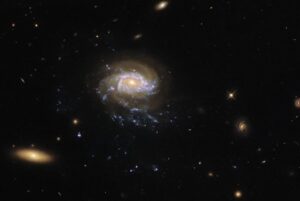This spectacular image from the NASA/ESA Hubble Space Telescope captures a stunning view of a “jellyfish galaxy” with beautiful trailing tentacles of stars suspended against the vast inky blackness of space. As jellyfish galaxies traverse through the depths of intergalactic space, they leave a trail of gas slowly being stripped away that resembles tendrils, illuminated by clumps of young and vibrant star formation.
Located in the constellation Cetus, JO201 is a jellyfish galaxy characterized by beautiful blue tendrils extending out from beneath its core. Giving it an unmistakable jellyfish-like appearance, JO201 is an awe-inspiring example of celestial beauty, and its name pays homage to the sea monster of ancient Greek mythology. The sea-monster-themed constellation in this image adds to the nautical theme, creating a unique and interesting visual display. This constellation is sure to captivate viewers with its intricate details and mythical designs.
Jellyfish galaxies are fascinating and mysterious space phenomena, characterized by long, extended tendrils reaching beyond the bright disk of their galactic core,These structures, composed of stars, dust and gas. The researchers’ study examines the size, mass and age of clusters of star formation in the jellyfish galaxy clusters. Through detailed observations, the investigation aims to gain a better understanding of the processes behind star formation in these unique galactic structures.
Astronomers are in a race to learn more about the relationship between ram-pressure stripping and star formation—two processes vital to the formation of jellyfish galaxies. By studying the connection between these two phenomena, astronomers can get a better understanding of how galaxies form and evolve over time. Hubble’s Wide Field Camera 3 (WFC3) has captured a stunning galactic seascape that displays the versatility of this instrument. WFC3 is capable of capturing images in ultraviolet, infrared, and visible wavelengths, and is responsible for some of the most impressive images from the Hubble Space Telescope.


